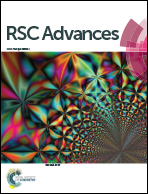Catalytic aerobic oxidation of 5-hydroxymethylfurfural into 2,5-diformylfuran over VO2+ and Cu2+ immobilized on amino-functionalized core–shell magnetic Fe3O4@SiO2
Abstract
Amino modified Fe3O4@SiO2 (Fe3O4@SiO2–NH2) was used to immobilize Cu2+ and VO2+ for preparing Fe3O4@SiO2–NH2–Cu2+ and Fe3O4@SiO2–NH2–VO2+ catalysts. Various technologies had been used for the characteristics of catalysts, such as XRD, XPS, FT-IR, SEM, TEM and VSM. The catalytic performance of Fe3O4@SiO2–NH2–VO2+ in HMF oxidation could be significantly enhanced by the use of Fe3O4@SiO2–NH2–Cu2+ as the co-catalysts. The type of reaction solvents showed a great influence on the oxidation of HMF. The highest HMF conversion reached up to 98.7% at 110 °C in toluene with an optimal 2,5-diformylfuran yield of 85.5%. Moreover, the Fe3O4@SiO2–NH2–Cu2+ and Fe3O4@SiO2–NH2–VO2+ catalyst exhibited great stability and could be readily applied in the next recycle after magnetic separation.


 Please wait while we load your content...
Please wait while we load your content...